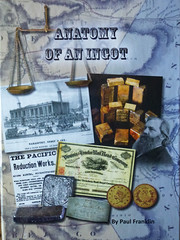
PREV ARTICLE
NEXT ARTICLE
FULL ISSUE
PREV FULL ISSUE
NEW BOOK: ANATOMY OF AN INGOT
At my request author Paul Franklin forwarded the following press release about his new book, Anatomy of an Ingot . Thanks! Paul is the son of Gerow Paul Franklin, the associate of John Ford discussed in Karl Moulton's book, John J. Ford Jr. and the "Franklin Hoard". Paul's book addresses the history of one particular silver ingot from the Ford collection, so this may be another of the "single coin books" that I enjoy for their focused, in-depth numismatic research. I haven't seen it yet, but hope to soon.
-Editor
The most significant of the three assayers was Guido Kustel, who worked in the early San Francisco assay business with well-known names such as Wass, Molitor and Harazsthy. A German trained Mining Engineer and Metallurgist, Kustel ventured off to the Apache infested mountains of Southern Arizona to build the first assay and refining facilities at the famous Heintzelman Mine. He returned to California just in time to become one of the principal players in the early Comstock mining boom in Nevada. Although not a household name today, Kustel was one of the most famous mining engineers and assayers of his day, publishing three books that became ‘must haves’ for every mining engineer. He returned to San Francisco where he set up a number of assay offices and refineries. The second player was Eugene N. Riotte, also trained in Germany, who travelled to Nevada just in time to participate in the newly discovered Reese River silver mines around Austin. He was later involved with a number of other assayers and mining engineers in solving the problems in refining the complex silver ores of Nevada. The third member, Henry Mathey, emigrated from the gold mines of South America to the early mines of Darwin near Death Valley. Joining Kustel and Riotte in 1880 they set the stage for the origin of the silver ingot in question, but not in a way that one might have guessed. Mathey would go onto other achievements including developing the first tin mine in the United States. Along the way you meet a number of interesting and perhaps familiar names:
The book is lavishly illustrated with 145 illustrations, (many published for the first time) and over 550 references on 251 pages of high quality glossy stock. The author has mainly used primary resources in researching the book and provides a richly detailed bibliography. At the end are a number of appendices, one which traces the history of assaying and provides descriptions of the processes as practiced during the period. The book, self-published, is priced at $39.95 and can be purchased by contacting Paul Franklin at
pgfranklin@charter.net
or calling 775-849-0295.
The Numismatic Bibliomania Society is a non-profit organization promoting numismatic literature. See our web site at coinbooks.org. To submit items for publication in The E-Sylum, write to the Editor at this address: whomren@gmail.com To subscribe go to: https://my.binhost.com/lists/listinfo/esylum All Rights Reserved. NBS Home Page Contact the NBS webmaster 
|
